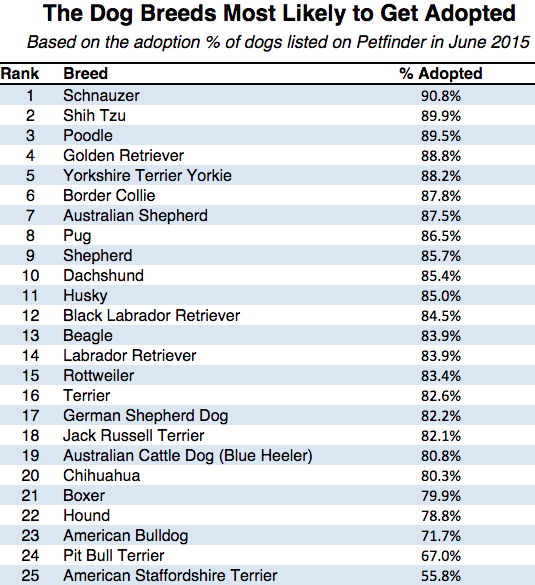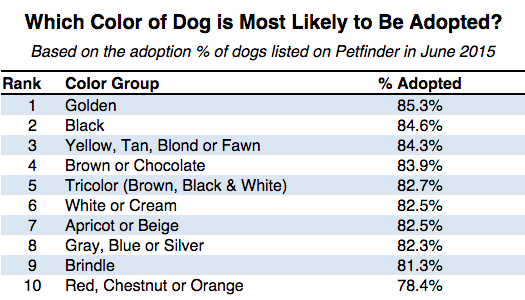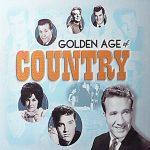As dog rescuers of Dachshunds and Weimaraners, we found this article interesting, as we think you will. Our senior foster dog, Max is still waiting for a forever home... Rob and Tom
 What Kinds of Pets Get Adopted?
What Kinds of Pets Get Adopted?
The United States is a pet loving nation. No country in the world houses more cats and dogs. Currently, over 60% of American households contain one pet, and pet ownership is on the rise. The country is full of deluxe pet boutiques and home to a wildly popular Internet Cat Video Festival.
American pets are often “rescues”. Twenty percent of the approximately eighty million dogs owned in this country were adopted from pet shelters, as were a quarter of the one hundred million cats.
Yet many of the approximately 3.9 million dogs and 3.4 cats that enter animal shelters every year will never be adopted. In fact, more of these animals will be euthanized than taken in to a new home.
Given
the stark contrast in outcomes for pets in shelters, we were curious
about the factors make dogs and cats more likely to get adopted. In
order to understand this, we analyzed the adoption rates of over 80,000
pets listed on the internet adoption site Petfinder.
We found that for both dogs and cats, age, size and breed were highly
correlated to outcomes. The future is much bleaker for a big, old,
terrier, than it is for a young, small schnauzer.
Previous research indicates that prospective adopters care about factors such as an animal’s appearance, friendliness, health, age and breed type. There is also evidence that the color of an animal’s fur impacts adoption likelihood.
Our
study focuses on physical characteristics that can be assessed before
meeting the dog in person. The findings are unusual because they are
based on such a large sample of animals.
According to our analysis, cats that are black and white are less likely to be adopted.
Petfinder is the internet’s largest adoption site listing
nearly 400,000 adoptable pets from over 13,000 shelters across every
region of the United States. The company claims to have arranged well
over 17 million
adoptions. The vast majority of animals listed on the site are for cats
and dogs, but you can also find birds, rabbits, mice, snakes and
iguanas.
Each potential pet has
its own listing page that contains a variety of information. This
information includes the animal’s name, breed, age group (baby, young,
adult, senior), sex, size, shelter name, and location. The Petfinder
page for the labrador retriever mix Cooper, who is still up for adoption at the Safe Hands Animal Rescue, is shown below.
Cooper’s page on Petfinder.
In
order to understand which characteristics are correlated with higher
adoption rates, we analyzed the adoption results of over 83,000 animals
whose Petfinder page was created in 2015 between June 1st and June
25th.
If the animal was
adopted, Petfinder tags that animal as “Adopted.” 77% of the animals in
our sample have been adopted as of September 5th. This is much higher
than the rate at which animals typically get adopted, which is closer to
35%.
This difference is likely attributable to a selection of bias in terms
of which animals are listed on Petfinder, and the fact that certain
animals are removed from the website by shelters for reasons that are
often unknown to Petfinder (perhaps because they were euthanized).
Which Kinds of Dogs Get Adopted?
Humans developed
dog breeds to exhibit different personal and physical traits.
Apparently, certain traits are significantly more or less appealing to
adopters as there is substantial variation in adoption rates by breed
type. Schnauzers and shih tzus seem to be particularly desirable, and
bulldogs and terriers much less so.
The following table displays all breeds with over 500 dogs in the dataset along with their adoption rates.

The
American Staffordshire Terrier is the least likely breed to be adopted.
The chances are even worse for Staffordshire Terrier’s who are not
babies, as they get adopted at a rate of less than 50%. Chihuahuas and
pit bull terriers are the two most common breeds available, and also
among the least likely to be adopted. This follows previous research
that suggests highly overrepresented breed types are less likely to get adopted.
Age is also an important characteristic in determining the likelihood of adopted. Previous research has suggested that older dogs are less likely to get adopted, and our research bears this out. In fact, this is the most important factor we found. Unpredictable as they may be, people love puppies.

Though
the effect is weaker than age, size also seems to have an important
impact on the adoption decision. The following table shows that the
smaller the dog, the more likely to be adopted. Bad news for Clifford if he ever ends up at a shelter.

Though much has been written about the impact of color on dog adoption rates (specifically the “black dog syndrome”) and there is some strong evidence that a discrimination exists,
we don’t find a strong bias against certain color dogs our analysis of
dogs. The next table shows the adoption rates for dogs with different
color descriptions (to be included on the list, there must have been at
least 500 dogs with this color description).

We
also checked the relationship between the sex of the dog and adoption
rates. This seemed to have very little impact on the dog adoption
decision. 82% of females were adopted and 81% of males.



